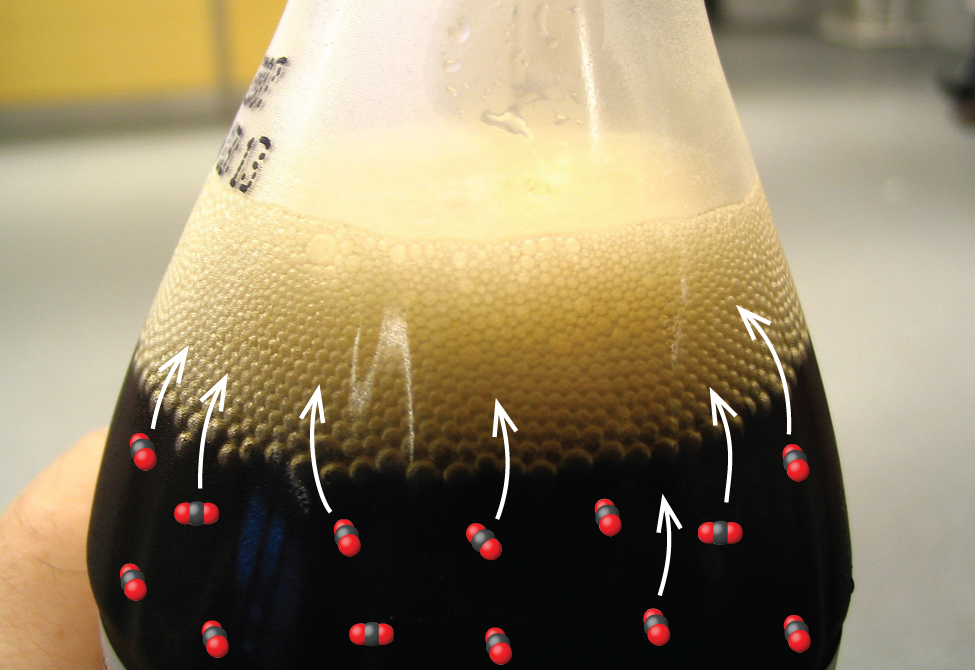| << Chapter < Page | Chapter >> Page > |
In a chemical equilibrium, the forward and reverse reactions do not stop, rather they continue to occur at the same rate, leading to constant concentrations of the reactants and the products. Plots showing how the reaction rates and concentrations change with respect to time are shown in [link] .
We can detect a state of equilibrium because the concentrations of reactants and products do not appear to change. However, it is important that we verify that the absence of change is due to equilibrium and not to a reaction rate that is so slow that changes in concentration are difficult to detect.
We use a double arrow when writing an equation for a reversible reaction. Such a reaction may or may not be at equilibrium. For example, [link] shows the reaction:
When we wish to speak about one particular component of a reversible reaction, we use a single arrow. For example, in the equilibrium shown in [link] , the rate of the forward reaction
is equal to the rate of the backward reaction
The connection between chemistry and carbonated soft drinks goes back to 1767, when Joseph Priestley (1733–1804; mostly known today for his role in the discovery and identification of oxygen) discovered a method of infusing water with carbon dioxide to make carbonated water. In 1772, Priestly published a paper entitled “Impregnating Water with Fixed Air.” The paper describes dripping oil of vitriol (today we call this sulfuric acid, but what a great way to describe sulfuric acid: “oil of vitriol” literally means “liquid nastiness”) onto chalk (calcium carbonate). The resulting CO 2 falls into the container of water beneath the vessel in which the initial reaction takes place; agitation helps the gaseous CO 2 mix into the liquid water.
Carbon dioxide is slightly soluble in water. There is an equilibrium reaction that occurs as the carbon dioxide reacts with the water to form carbonic acid (H 2 CO 3 ). Since carbonic acid is a weak acid, it can dissociate into protons (H + ) and hydrogen carbonate ions
Today, CO 2 can be pressurized into soft drinks, establishing the equilibrium shown above. Once you open the beverage container, however, a cascade of equilibrium shifts occurs. First, the CO 2 gas in the air space on top of the bottle escapes, causing the equilibrium between gas-phase CO 2 and dissolved or aqueous CO 2 to shift, lowering the concentration of CO 2 in the soft drink. Less CO 2 dissolved in the liquid leads to carbonic acid decomposing to dissolved CO 2 and H 2 O. The lowered carbonic acid concentration causes a shift of the final equilibrium. As long as the soft drink is in an open container, the CO 2 bubbles up out of the beverage, releasing the gas into the air ( [link] ). With the lid off the bottle, the CO 2 reactions are no longer at equilibrium and will continue until no more of the reactants remain. This results in a soft drink with a much lowered CO 2 concentration, often referred to as “flat.”

Let us consider the evaporation of bromine as a second example of a system at equilibrium.
An equilibrium can be established for a physical change—like this liquid to gas transition—as well as for a chemical reaction. [link] shows a sample of liquid bromine at equilibrium with bromine vapor in a closed container. When we pour liquid bromine into an empty bottle in which there is no bromine vapor, some liquid evaporates, the amount of liquid decreases, and the amount of vapor increases. If we cap the bottle so no vapor escapes, the amount of liquid and vapor will eventually stop changing and an equilibrium between the liquid and the vapor will be established. If the bottle were not capped, the bromine vapor would escape and no equilibrium would be reached.

A reaction is at equilibrium when the amounts of reactants or products no longer change. Chemical equilibrium is a dynamic process, meaning the rate of formation of products by the forward reaction is equal to the rate at which the products re-form reactants by the reverse reaction.
What does it mean to describe a reaction as “reversible”?
The reaction can proceed in both the forward and reverse directions.
When writing an equation, how is a reversible reaction distinguished from a nonreversible reaction?
If a reaction is reversible, when can it be said to have reached equilibrium?
When a system has reached equilibrium, no further changes in the reactant and product concentrations occur; the reactions continue to occur, but at equivalent rates.
Is a system at equilibrium if the rate constants of the forward and reverse reactions are equal?
If the concentrations of products and reactants are equal, is the system at equilibrium?
The concept of equilibrium does not imply equal concentrations, though it is possible.

Notification Switch
Would you like to follow the 'Chemistry' conversation and receive update notifications?